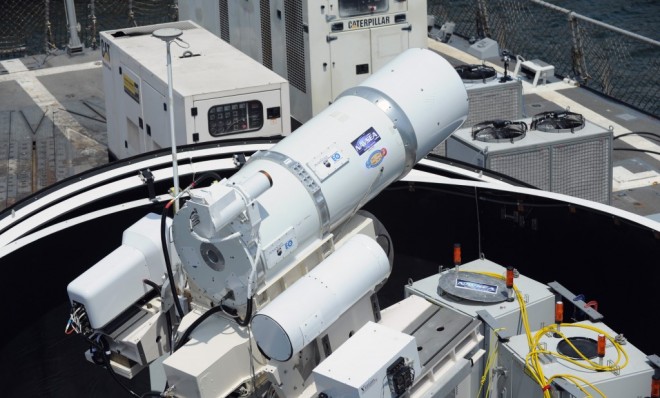WATCH: The U.S. Navy shoots down a drone with a laser cannon
The future of warfare is here, and "in the rock-paper-scissors game of modern combat, laser beats drone"


"The future is here," the U.S. Office of Naval Research's Peter Morrison said Monday, as the Navy unveiled a solid-state laser cannon that can disable or destroy surveillance drones and small, rapidly moving gunships.
"The Navy has been testing its boringly named Laser Weapons System (LaWS) for a few years now, and this isn't the first time it has ever blown something out of the sky," says Eric Limer at Gizmodo. But as the video above demonstrates, "it is the most spectacular look we've gotten yet" of the Navy's laser dreams in action.
Laser cannons may still seem like something out of science fiction, but they "are definitely the future of war," says Limer, "as are drones." And it "looks like in the rock-paper-scissors game of modern combat, laser beats drone." We should find out soon enough. The Navy announced that the LaWS is being sent out aboard the USS Ponce for a real-life field test in the Persian Gulf in fiscal 2014, which starts in October. "Pew pew pew." Lasers: "This is the future of warfare. And it's so, so cool."
The Week
Escape your echo chamber. Get the facts behind the news, plus analysis from multiple perspectives.

Sign up for The Week's Free Newsletters
From our morning news briefing to a weekly Good News Newsletter, get the best of The Week delivered directly to your inbox.
From our morning news briefing to a weekly Good News Newsletter, get the best of The Week delivered directly to your inbox.
Before anyone gets too excited, though, let's remember that "the Pentagon has a long history of grossly inflating claims for its experimental weapons," says Thom Shanker in The New York Times. This time, their claims are bolstered by a new report from the nonpartisan Congressional Research Service, which found that lasers on ships could bring about "a technological shift for the Navy — a 'game changer' — comparable to the advent of shipboard missiles in the 1950s." But at the same time, the current class of laser weaponry has its drawbacks.
Among the limitations, according to the research service, is that lasers are not effective in bad weather because the beam can be disturbed or scattered by water vapor, as well as by smoke, sand, and dust. It is also a "line of sight" weapon, meaning that the target has to be visible, so it cannot handle threats over the horizon. And enemies can take countermeasures like coating vessels and drones with reflective surfaces. Navy officials acknowledge that the first prototype weapon to be deployed is not powerful enough to take on jet fighters or missiles on their approach. [New York Times]
To take down a jet or missile, a laser beam would have to be at least 100 kilowatts, the strength "generally considered militarily mature," says Spencer Ackerman at Wired. At a megawatt of power, a laser "can burn through 20 feet of steel in a second." The current LaWS cannon — which generates its own power — falls far short of that, but it's evidently strong enough to punch through "an adversary's cheap anti-ship weapons," like drones and swarming fast boats. In fact:
It just so happens that the LaWS's ability to track and kill surveillance drones and swarming fast boats matches with Iran's development of surveillance drones and swarming fast-boat tactics. And it just so happens that the Ponce will spend most of 2014 deployed in Iran's backyard. [Wired]
That's one of the reasons the Navy is trotting out the LaWS now — it won't put it this way, but the laser cannon "has immediate implications for the U.S.' ongoing sub rosa conflict with the Iranians," Ackerman says. In this era of Pentagon belt-tightening, the Navy's bigger selling point for the dawn of "the age of the laser weapons is financial." The LaWS prototype cost just under $32 million to make, and more importantly, the Navy says the limitless supply of sustained laser bursts will cost less than $1 each, versus at least $5,000 per conventional shell or missile. (Each current short-range interceptor missile costs $1.4 million.)
A lot about that cost figure depends on successful integration aboard a ship's deck; successfully drawing from a ship's power without compromising the propulsion systems; and the cost of fuel per shot. And it also factors out the cost of the weapon itself. But if it turns out to be genuine, the Navy will have developed the rare high-end weapons system that undercuts the cost of adversary weapons.
The big concern in surface warfare is that anti-ship missiles are way cheaper than ships. The Navy can't make ships cheaper. (Let's be real.) But it might be able to develop a countermeasure to those anti-ship weapons cheaper than those weapons themselves. As the Navy sees it, that's the ultimate promise of laser guns: A weapon that undercuts the increasing cheapness and availability of powerful missiles and robots. It's by no means certain that the Navy can realize the promise. But it's now fully committed to trying. [Wired]
A free daily email with the biggest news stories of the day – and the best features from TheWeek.com
Peter has worked as a news and culture writer and editor at The Week since the site's launch in 2008. He covers politics, world affairs, religion and cultural currents. His journalism career began as a copy editor at a financial newswire and has included editorial positions at The New York Times Magazine, Facts on File, and Oregon State University.


